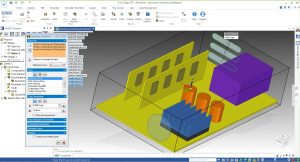In the high-stakes world of engineering, even minor design errors can lead to massive costs, safety hazards, or project delays. That’s why design verification is critical—it ensures your designs meet their intended purpose before moving into production or implementation. Whether you’re designing tunnels, HVAC systems, or structural elements, verifying your engineering designs boosts quality, reduces rework, and increases stakeholder confidence.
In this article, we’ll walk you through best practices for engineering design verification, including the most effective methods, tools, common pitfalls, and how to integrate verification seamlessly into your workflow.
What is Design Verification?
Design verification is the process of ensuring that a design accurately meets the specified requirements and performs as intended under expected conditions. It answers the question: “Did we design the system right?”
It differs from validation, which asks: “Did we design the right system?”
Verification often involves simulation, calculations, inspections, and testing at various stages of the design process to confirm compliance with:
- Technical specifications
- Regulatory codes (like AS/NZS or ISO)
- Safety and operational requirements
- Environmental and site-specific constraints
Importance of Verification in Engineering
Engineering projects operate under strict constraints—tight budgets, regulatory compliance, and public safety. Failing to properly verify a design can have severe consequences:
- Safety risks: Undetected design flaws may lead to structural failures or operational hazards.
- Financial losses: Rework, lawsuits, or construction halts caused by errors can dramatically increase costs.
- Reputational damage: Poor design practices can tarnish an engineering firm’s image and reduce client trust.
Proper verification helps:
- Detect issues early in the design process
- Ensure compliance with standards
- Improve quality and durability of final products
- Reduce lifecycle costs
- Facilitate smoother project approvals and client handovers
Methods for Design Verification

Manual Review and Peer Checking
A traditional but effective method. Engineers manually review drawings, calculations, and models for errors or discrepancies. Peer reviews and design walkthroughs often uncover overlooked issues.
Analytical Calculations
Verification using hand or spreadsheet-based calculations ensures results align with fundamental engineering principles. It’s especially effective for checking simulation outputs.
Finite Element Analysis (FEA) & Computational Fluid Dynamics (CFD)
Using simulation tools to verify design performance under load, stress, temperature, or flow conditions. These help assess the physical behavior of components or systems with precision.
Checklists and Standard Protocols
Structured verification checklists aligned with codes (e.g., AS/NZS 1170, Eurocode, or AISC) ensure all critical aspects are examined systematically.
Prototyping and Testing
Involves physical testing of prototypes under real-world conditions. Though costly, it’s often essential for products exposed to critical loads or environmental extremes.
Third-party Verification
Bringing in external experts or certified reviewers to assess complex or high-risk designs adds another layer of assurance and compliance.
Common Pitfalls to Avoid
Despite the best intentions, many teams fall into traps that reduce verification effectiveness. Avoid these common issues:
Assuming Simulation is Always Accurate
Simulations are only as good as their assumptions. Mesh quality, boundary conditions, and material properties must be verified themselves.
Lack of Traceability
Without clear documentation, it’s difficult to trace whether a design change was verified properly, leading to costly oversights.
Over-Reliance on One Verification Method
Using only FEA or manual checks introduces blind spots. A mix of techniques ensures better coverage.
Skipping Verification for Minor Changes
Even small changes can have a ripple effect, especially in interdependent systems like MEP or structural designs.
Rushing Verification Under Deadlines
Time pressure often leads to skipping critical checks, increasing risk. Always allocate sufficient time for thorough review.
Tools and Software for Verification
There’s a wide range of tools available to support engineering verification, depending on the type of project and discipline.
For Structural and Civil Design:
- ANSYS Mechanical, Abaqus, ETABS, and SAP2000 for stress and structural analysis.
- Mathcad or Excel for detailed engineering calculations.
- AutoCAD, Revit, and Tekla for model review and coordination.
For Mechanical and HVAC Systems:
- SolidWorks Simulation
- COMSOL Multiphysics
- Carrier HAP and Trace 700 for HVAC load analysis
- CFD software like ANSYS Fluent for flow simulations
For Workflow and Documentation:
- Bluebeam Revu for markup and PDF reviews
- BIM 360 or Trimble Connect for real-time collaboration
- Requirement management tools like Jama or Helix RM for traceability
At Avesta Consulting, we use a combination of these tools depending on project complexity, budget, and client requirements to ensure designs are verified efficiently and accurately.
Future Trends in Design Verification
The field of verification is evolving rapidly, driven by digital transformation and increasing complexity in engineering systems. Key trends include:
Integration of Machine Learning (ML)
ML is being used to detect design anomalies or predict failure conditions based on prior simulation and test data.
Model-Based Verification
Using fully digital twins of engineering systems to verify performance in a virtual environment, especially in aerospace, automotive, and infrastructure.
Cloud-Based Simulation and Review Platforms
These allow distributed teams to collaborate, verify, and update designs in real time.
Automated Code Compliance Tools
New software tools can scan models for code compliance (like AS/NZS, ISO, or NFPA) automatically—saving time and reducing human error.
Real-Time Sensor Feedback
In smart buildings or factories, real-time sensor data is fed back into design models to verify assumptions and improve future designs.
How to Implement Verification in Your Workflow
Step 1: Establish Verification Objectives
Clearly define what needs to be verified: performance under load, energy efficiency, code compliance, etc. Align with project specifications.
Step 2: Develop a Verification Plan
Detail the who, what, and how of verification:
- Who is responsible for reviews?
- What tools or standards will be used?
- When will verification take place (milestones)?
Step 3: Use Templates and Checklists
Standardizing your approach ensures consistency and saves time across projects.
Step 4: Train Your Team
Ensure everyone involved understands the importance and methodology of design verification. Encourage cross-discipline peer reviews.
Step 5: Maintain Verification Records
Store calculations, reports, peer review notes, and compliance checklists in a centralized, traceable format. This is critical for audits, quality control, and client transparency.
Step 6: Review and Improve Continuously
After project delivery, conduct a post-mortem to see what worked and where verification could have been improved. Feed those lessons into future workflows.
Conclusion
Design verification isn’t just a checkbox—it’s a vital part of engineering excellence. Whether you’re designing infrastructure, fluid systems, or energy-efficient buildings, rigorous verification ensures safety, performance, and compliance.
At Avesta Consulting, we bring a verification-first mindset to every engineering project. Our simulation, design, and review processes are structured to reduce risks and maximize value for our clients across Australia and beyond.
Need help integrating advanced verification into your engineering workflow? Contact our team today for expert consulting and simulation support.




